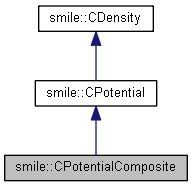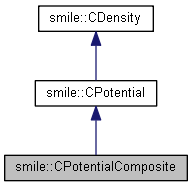 |
SMILE
v2.5
Schwarzschild Modelling Interactive expLoratory Environment
|
 |
SMILE
v2.5
Schwarzschild Modelling Interactive expLoratory Environment
|
A composite potential which consists of several other potential types, plus a possible black hole and a rotating reference frame. More...
#include <potential.h>


Public Member Functions | |
| CPotentialComposite (const std::vector< const CPotential * > &_components, double _Mbh=0) | |
| construct the composite potential from the provided list of components, and optionally a central black hole. More... | |
| virtual CPotential * | clone () const |
| Return a pointer to a copy of this instance of potential. More... | |
| virtual POTENTIALTYPE | PotentialType () const |
| enumerable potential type | |
| virtual const char * | PotentialName () const |
| string representation of potential type | |
| virtual SYMMETRYTYPE | symmetry () const |
| returns symmetry type of this potential | |
| virtual double | Rho (double X, double Y, double Z, double t=0) const |
| returns density at given coordinates, this should obviously be overriden in derivative classes | |
| virtual double | Phi (double X, double Y, double Z, double t=0) const |
| Return potential at a given spatial point (possibly a time-varying one). More... | |
| virtual void | Force (const double xyz[N_DIM], const double t, double *force, double *forceDeriv=NULL) const |
| Compute forces and, optionally, force derivatives at a given point. More... | |
| size_t | size () const |
| return the number of potential components | |
| const CPotential * | component (size_t index) const |
| return the pointer to the given component | |
| virtual double | Mass (const double r) const |
| returns mass inside given radius (approximately! not necessary to integrate density over sphere, just a rough estimate used e.g. in choosing radial nodes of Schwarzschild grid) | |
 Public Member Functions inherited from smile::CDensity Public Member Functions inherited from smile::CDensity | |
| virtual double | totalMass () const |
| returns estimated M(r=infinity) or -1 if mass is infinite | |
| double | getRadiusByMass (const double m) const |
| solves for Mass(r)=m | |
| void | getRadiiByMass (const vectord &masses, vectord *radii) const |
| solves for Mass(r)=m for an array of sorted values of m (more efficient than doing it one-by-one) | |
| bool | checkMassMonotonic () const |
| safety measure: check (roughly) that mass is increasing with radius | |
| bool | checkDensityNonzero () const |
| another safety measure: check that density doesn't drop to zero along any of three axes (important to assess spherical-harmonic approximation quality) | |
| virtual double | getGamma () const |
| returns inner density slope estimate (only used in BSE potential expansion for the automatic selection of shape parameter Alpha) | |
Static Public Member Functions | |
| static const char * | myName () |
Private Attributes | |
| std::vector< const CPotential * > | components |
| list of components (each one represented by an instance of CPotential derivative class) | |
| const double | Mbh |
| mass of central black hole(s) | |
Additional Inherited Members | |
 Public Types inherited from smile::CDensity Public Types inherited from smile::CDensity | |
| enum | POTENTIALTYPE { PT_UNKNOWN, PT_DIRECT, PT_COMPOSITE, PT_COEFS, PT_NB, PT_BSE, PT_BSECOMPACT, PT_SPLINE, PT_CYLSPLINE, PT_LOG, PT_HARMONIC, PT_SCALEFREE, PT_SCALEFREESH, PT_SPHERICAL, PT_DEHNEN, PT_MIYAMOTONAGAI, PT_FERRERS, PT_PLUMMER, PT_ISOCHRONE, PT_PERFECTELLIPSOID, PT_NFW, PT_SERSIC, PT_EXPDISK, PT_ELLIPSOIDAL, PT_MGE } |
| list of all existing types of density or density/potential models, each of them implemented in its own class More... | |
| enum | SYMMETRYTYPE { ST_NONE = 0, ST_REFLECTION = 1, ST_PLANESYM = 2, ST_ZROTSYM = 4, ST_SPHSYM = 8, ST_TRIAXIAL = ST_REFLECTION | ST_PLANESYM, ST_AXISYMMETRIC = ST_TRIAXIAL | ST_ZROTSYM, ST_SPHERICAL = ST_AXISYMMETRIC | ST_SPHSYM, ST_DEFAULT = ST_TRIAXIAL } |
| Type of symmetry. More... | |
A composite potential which consists of several other potential types, plus a possible black hole and a rotating reference frame.
| smile::CPotentialComposite::CPotentialComposite | ( | const std::vector< const CPotential * > & | _components, |
| double | _Mbh = 0 |
||
| ) |
construct the composite potential from the provided list of components, and optionally a central black hole.
| [in] | _components | contains the array of pointers to potential components (may be an empty list). It may be an empty array, but should not contain NULL pointers. The supplied potentials are cloned in the constructor and subsequently the cloned instances are deleted in the destructor. |
| [in] | _Mbh | is the mass of central black hole (may be zero). |
|
inlinevirtual |
Return a pointer to a copy of this instance of potential.
A standard copy constructor or assignment is disabled because of different amount of data needed to be copied in different derived classes).
Implements smile::CPotential.
|
virtual |
Compute forces and, optionally, force derivatives at a given point.
| [in] | xyz | - coordinates of the point to compute forces (array of 3 numbers) |
| [in] | t | - time to compute forces (matters only if potential is time-dependent) |
| [out] | force | - computed values of -d Phi/d x_i; output array must exist and contain N_DIM values. |
| [out] | forceDeriv | - if not NULL, then also compute the second derivatives of potential (which is a symmetric matrix of size N_DIM^2, thus the array must be of size N_DIM*(N_DIM+1)/2 ): first 3 values contain  , second three contain mixed derivatives , second three contain mixed derivatives  . . |
Implements smile::CPotential.
|
virtual |
Return potential at a given spatial point (possibly a time-varying one).
Implements smile::CPotential.
 1.8.8
1.8.8